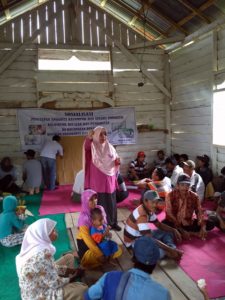
The success of the Smart Tree-Invest project’s farmers’ learning groups has caught the eye of Indonesia’s Buol District Agricultural Office. It has now begun to fund and replicate the approach itself.
In early March 2017, the Buol district administration in Central Sulawesi province, Indonesia, began to replicate a farmers’ learning group approach in Bukal subdistrict, with funding from the district’s own development budget. Bukal is located next to the important and degraded Lantika Digo-Mulat watershed.
A survey conducted in February 2017 determined which villages in Bukal had the best potential for agroforestry development, a proven approach for improving farmers’ incomes and farm productivity while also protecting the environment.
The survey team, consisting of representatives of Buol District Agricultural Office and the Climate-smart, Tree-based, Co-investment in Adaptation and Mitigation in Asia (Smart Tree-Invest) project (supported by the International Fund for Agricultural Development), decided the criteria for potential villages. These included that local farmers were interested in agroforestry; there were suitable locations for planting trees; water was available for tree nurseries; and there was a low risk of flooding.
Watch: An introduction to the Smart Tree-Invest project
Three villages — Rante Marannu, Bukal and Potangoan — were chosen because they met all the criteria. Moreover, the three villages’ agricultural extension officers were thrilled at the prospect of taking part in the program, which runs from March to December 2017 under the Extension Unit of the Agricultural Office led by Nurhayati Mentemas.

The World Agroforestry Centre (ICRAF), which led the Smart Tree-Invest project that forms part of the CGIAR Research Program on Forests, Trees and Agroforestry (FTA), had earlier committed to help the government in technical preparation and staff support until the end of the project in April 2017. This included training trainers of agricultural extension staff, budgeting for activities, and sharing information about sources of seeds and other supplies.
The farmers’ learning group approach involved holding focus groups in each of the three villages, which led to the establishment of new groups that aimed to share knowledge of best-practice agroforestry farming techniques. The groups in the three villages selected the commodities they wanted to cultivate through playing ‘button games’ facilitated by the extension officers.
Cocoa, durian, clove, nutmeg and pepper were the commodities chosen, which correlated with those earlier identified in the project’s original learning groups in Tiloan and Gadung subdistricts in Buol. The new learning groups’ members from the three villages were eager to participate and welcomed the program.
“It is a new kind of approach,” said Nursal, one of the farmers. “We’re very excited to learn new things and be in contact with the government.”
Read also: Indonesian district government funds replication of ICRAF approaches
By the second week of April, three nurseries associated with the learning groups had been established. Cocoa and pepper had also been planted and the next step was to cultivate durian, clove and nutmeg seedlings.
Mansur, a government agricultural extension officer, said the program was new and exciting, mainly because of its participatory approach. “For the past few years, maize has been the main commodity that has had government support which was always decided through the policies of the district government,” he said.
“However, lately many farmers have been thinking that other commodities, such as pepper, might also have potential. So it is very exciting to cultivate pepper together with the farmers. It turned out that most of them were interested all along but weren’t sure where to start.”
The Buol administration’s aim is to ensure that the activities started under the Smart Tree-Invest project will be sustainable despite ICRAF’s departure from the site.
“We’re very happy that the learning group members are excited about the program,” added Mentemas of the Extension Unit. “We’ll do our best to support them.”
By Rob Finlayson and Dienda CP Hendrawan, originally published at ICRAF’s Agroforestry World.
This work was supported by the CGIAR Research Program on Forests, Trees and Agroforestry. We thank all donors who support research in development through their contributions to the CGIAR Fund.











